What Are Some of the Pathogens You’ll Find in a Medical Practice?
Pathogens are varied in types and numerous in quantity. Throughout the world, there are more than thousands of different kinds of specific strains, bacteria, fungi, you name it. Some are quite similar to each other, some are vastly different. Listing them all would take quite some time, and saying what each one did would go even further. But it’s important to be knowledgable on the kinds you might run into if you work a job where infection prevention plays a huge role. Like in a medical practice for example. One of the key elements to ensuring worker and patient safety is infection control.
In this article, we’d like to take a slightly different approach to the way we talk about pathogens. And right now, we’ll go over the various types of bacteria, viruses and fungi you’ll run into in a medical practice. This is by no means a complete list, but it’s a slightly more comprehensive look at some of the more common entries. After telling you a bit about each, we’ll also offer some of our personalized solutions to ensure that if you ever run into any of them, that you’ll be prepared to take proper action.
Bacteria
Bacteria, in this case specifically they’re harmful bacteria or pathogenic bacteria, are single-celled microorganisms that can cause disease and infection by invading a host and multiplying rapidly. These bacteria often produce toxins that damage the host tissue and disrupt the normal biological function, resulting in illnesses. These bacteria thrive by evolving to become resistant to antibacterial solutions like cleaners and some mild disinfectants. Which is why the industry is constatnly finding new and improved ways to combat all kinds of bacteria, including the more resistant types.
These bacteria are either endemic to healthcare settings due to environmental survival or are common causes of Healthcare-Associated Infections (HAIs) due to said antibiotic resistance. Let’s look at some examples of these bacteria.
Clostridioides difficile (C. difficile)
Clostridioides difficile produces highly resilient spores that survive on environmental surfaces (floors, toilets, equipment) for months and are easily transmitted on hands or clothing, infecting vulnerable, antibiotic-treated patients.
Staphylococcus aureus (MRSA, VISA, VRSA)
Staphylococcus aureus commonly colonizes the skin and nose of patients and staff, easily shedding onto high-touch surfaces where it can survive until it infects surgical or open wounds.
Pseudomonas aeruginosa:
Pseudomonas aeruginosa thrives in moist, aqueous environments like drains, sinks, and respiratory therapy equipment, posing a high risk of infection when transferred to open wounds or the respiratory tract.
Acinetobacter baumannii
Acinetobacter baumannii is known as a “superbug” that survives extremely well on dry, inanimate surfaces, often leading to outbreaks in intensive care and acute care settings.
Vancomycin-Resistant Enterococci (VRE)
Vancomycin-Resistant Enterococci is part of the normal gut flora that becomes pathogenic; it spreads rapidly via contaminated hands and equipment because of its resistance to common antibiotics.
Klebsiella pneumoniae (KPC strains)
Klebsiella pneumoniae is often found in the gut or respiratory tract; its highly resistant strains cause serious infections (e.g., pneumonia, bloodstream) and persist on environmental surfaces.
Escherichia coli and Salmonella enterica
E. coli and Salmonella are common enteric (gut) bacteria that indicate fecal contamination of the environment or poor hygiene practices, posing an infection risk through the fecal-oral route.
Staphylococcus epidermidis
Staphylococcus epidermidis is a normal skin organism that poses a risk when patients have invasive devices (like catheters or IV lines) that provide a direct pathway into the bloodstream.
Mycobacterium tuberculosis
Mycobacterium tuberculosis is spread primarily through airborne droplets in shared waiting or examination rooms, making practices dealing with respiratory patients a risk area.
Legionella pneumophila
Legionella pneumophila is found in building water systems; risk occurs when contaminated water droplets are aerosolized (e.g., in nebulizers or sinks) and inhaled by susceptible patients.
Viruses
Viruses aren’t necessarily living organisms. They’re actually just DNA or RNA wrapped in protein shells. They can’t reproduce on their own, so they invade a host’s functioning cells and essentially hijack them to force it to create copies of the virus. That’s what makes them so contagious, and why it only takes a small amount of the virus to start an infection. These viruses in particular can be incredibly resilient with a low infectious dose, and are easily transferred from surfaces to the mouth, nose, or eyes of patients and staff.
Norovirus and Rotavirus
Norovirus and Rotavirus are highly resistant non-enveloped viruses that are shed in large numbers in feces and vomit, rapidly contaminating large areas of a practice via the fecal-oral route.
Influenza Virus (Types A and B) and Human Coronavirus
Influenza and coronavirus spread easily via respiratory aerosols and droplets that settle on high-touch surfaces, such as waiting room chairs and desks, before being picked up by hands.
Rhinovirus and Adenovirus
Rhinovirus and Adenovirus are non-enveloped and very hardy, they survive long periods on surfaces and are the most common causes of respiratory illness transmission in close-quarter settings.
Hepatitis B, Hepatitis C, and HIV
Hep B, Hep C and HIV are bloodborne pathogens present a persistent risk of transmission in any setting that involves needles, phlebotomy, surgical procedures, or the handling of blood and body fluid spills.
Respiratory Syncytial Virus (RSV) and Cytomegalovirus (CMV)
RSV and CMV are common in pediatric and prenatal practices, respectively, as they spread easily through direct contact and respiratory secretions in high-traffic patient areas.
Herpes Simplex Virus (HSV)
HSV is transmitted through contact with infected lesions or secretions, posing a risk during direct patient care or contact with contaminated materials.
Fungi
Fungi and yeasts aren’t mentioned as much as bacteria and viruses, but they’re still vitally important to know about. They present a unique, yet still dangerous threat to healthcare environments. You’ll se them categorized as “opportunistic colonizers,” and as the name implies, they take advantage of those with weak or compromised immune systems. They rarely harm more healthy individuals.
They’re environmental survivors, and they exist as spores or even drug resistant yeasts, like C. auris. They are extremly adaptive and can thrive effectively on surfaces and equipment. Which would require specialized fungicidal disinfectants to ensure complete elimination.
Candida auris (C. auris)
C. auris is an emerging, multi-drug resistant fungus that is highly successful at colonizing environmental surfaces and medical equipment, making it a severe contamination risk.
Candida albicans
Candida albicans is a common yeast that colonizes human skin and mucosal surfaces; its presence on environmental surfaces signals contamination, especially in areas serving immunocompromised patients who are susceptible to thrush and systemic infections.
Aspergillus and Penicillium species
Aspergillus and Penicillium are ubiquitous environmental molds whose spores are constantly in the air. High surface loads or uncontrolled air movement in a practice can lead to life-threatening invasive infections if spores are inhaled by severely ill or transplant patients.
Cryptococcus neoformans
Cryptococcus neoformans is found in environmental sources (soil, bird droppings); it poses a risk when patients with severely compromised immune systems inhale the fungal spores.
Trichophyton and Microsporum species
Trichophyton and Microsporum are dermatophytes (fungi causing skin, hair, and nail infections) that are easily spread through contaminated flooring, towels, or medical examination beds.
What are Some Solutions to Use?
You just got done reading about all of the various pathogens and bacteria, and your next question is probably: “what can I do about it?” Thankfully, there are various solutions to fit your infection prevention needs. Whether it’s surface disinfection or personal protection, we can help you! So let’s see what you can add to your arsenal to combat these harmful pathogens.
Surface Disinfectants
A timeless classic. When it comes to touch-friendly surfaces, your best friend will be the surface disinfectants. And where better to start than with some quality wipes? Ranging from your basic bacterial terminators, all the way to virucidal and fungicidal disinfectants. With chemical compounds that can lay those pathogens to rest for good, and ensuring the safety of both you and your workplace.
Metrex CaviWipes
Metrex CaviWipes are like the solid, reliable all-purpose cleaner in the clinic. They use a gentle-yet-effective cleaning chemical we call an “enhanced Quat” mixed with rubbing alcohol. The best thing about them is they are known for being super safe for sensitive equipment. If you need to wipe down expensive monitors or plastic tools without worrying about damage, CaviWipes are your go-to for daily, basic germ fighting.
- Good for All-Around Germs: They knock out most common bacteria, fungus, and those nasty blood-carried viruses (like and ).
- Gentle on Gear: Designed specifically to not damage pricey, sensitive electronics and plastics.
- Ready for Everything: The standard, reliable wipe for cleaning up average messes in patient areas.
- Pretty Fast: Gets the job done and kills germs in just 2 or 3 minutes.
You can find more info on the Metrex CaviWipes on our site here. →
PDI Super-Sani Cloth Wipes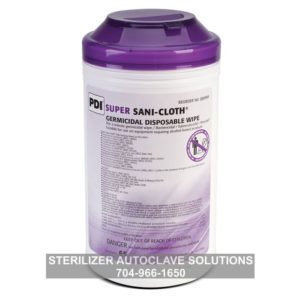
PDI Super Sani-Cloth is another market leader, and when the mess is a little heavier, these are the wipes you grab. They are the workhorse wipes because they pack a higher dose of alcohol mixed with the cleaning chemical. That extra alcohol is great because it acts like a scrub brush, cutting through dirt, grime, and body fluids before the germ-killer does its job. This combination makes them super fast and powerful for areas that see a ton of people, and they even kill the really tough bugs like the one that causes .
- Super Fast Cleanup: Kills most germs quickly, often in just 2 minutes, for speeding up room cleaning.
- Heavy Duty Cleaner: High alcohol content cuts through dirt and grime instantly, cleaning as it disinfects.
- Kills the Tough Bugs: Certified to destroy harder-to-kill bacteria, including the one that causes Tuberculosis ().
- No Dry Wipes: They have a special lid system that keeps every single wipe soaking wet and ready to work.
You can find more info on the PDI Super Sani-Cloth Wipes on our site here. →
Optim1 Wipes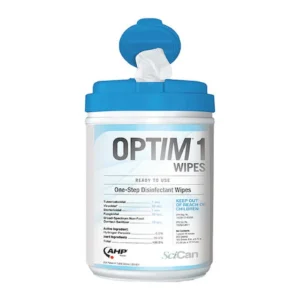
Optim 1 is the next-level, super-powered wipe. It uses a game-changing formula called Accelerated Hydrogen Peroxide (). Forget waiting around—this stuff is ridiculously fast, wiping out the widest range of germs (bacteria, fungi, and viruses) in 60 seconds or less. This is the wipe you use when you absolutely, positively have to kill the most stubborn germs, especially the ones that laugh at standard cleaners, like the super-nasty Norovirus (the stomach flu that won’t die). Plus, after it works, the formula just vanishes, breaking down into plain water and oxygen, making it incredibly safe for the person cleaning and great for the environment.
- Instant Kill Time: Destroys almost all germs in 60 seconds or less—the fastest professional wipe available.
- Kills the Worst Germs: Reliable against the hardest-to-kill viruses (like Norovirus) that other wipes struggle with.
- Super Safe Formula: Low-smell, non-irritating, and breaks down into water, so it’s much safer than bleach.
- One Wipe Does It All: Cleans the dirt and kills the germs completely in a single pass.
You can find more info on the Optim1 Wipes on our site here. →
Personal Protection Equipment
Once you’ve worried about every possible surface that you can, maybe it’s time to worry about yourself. personal protection equipment is the armor and shielding you wear into battle to protect yourself against incoming attacks. These bacteria can spread from air and fluid, so you need armor that can cover you properly. Luckily, we have a few suggestions in mind that can keep that barrier airtight.
Halyard’s Various Options
Halyard is one of the biggest names in personal protection equipment in the market today. They have a wide variety of equipment, ranging from gloves to masks, and even isolation gowns. They offer the perfect balance of both comfort and maximum protection in everything they create. So if you’re looking for some better armor in your everyday work, then we know just where to start.
What are Halyard’s Nitrile Gloves?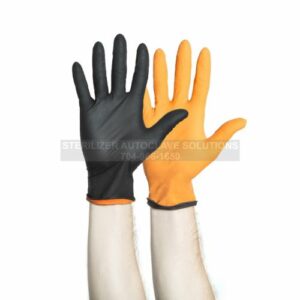
Halyard’s nitrile glove offerings aren’t just a single glove; they are a complete protection system designed to keep you safe and comfortable across every task.Whether you’re a medical professional or want strong protection in a regular situation, Halyard creates their products with the user in mind.
Built entirely with nitrile material, these gloves eliminate the risk of natural rubber latex allergies for both staff and patients, while still providing excellent resistance against punctures a variety of chemicals, both casual and even some rated against potent chemotherapy drugs. Their gloves range in ratings anywhere from their standard nitrile gloves to their specialty rated gloves, like the Halyard Black-Fire glove which you can see on the right.
Where Halyard really shines is in addressing both high-risk needs and the daily comfort of the user. Their specialized portfolio includes gloves that are certified for handling extremely dangerous substances, like chemotherapy drugs and concentrated Fentanyl, which gives frontline workers total confidence during critical tasks. Halyard aims to be the reliable and quality-focused option that provides not only certified barrier protection that can meet or even exceed the standards in place… but also ensures a comfortable, irritation-free experience for the staff wearing them for hours every day.
You can find more info on Halyard’s selection of Nitrile Gloves on our site here. →
What are Halyard N95 Respirators?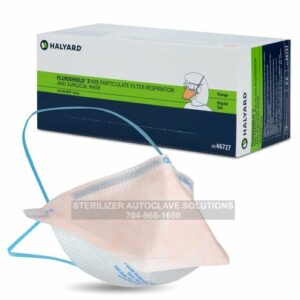
Another one of Halyard’s best choices in PPE is their Fluidshield N95 Respirator.
The Halyard FLUIDSHIELD N95 Respirator is a specialized mask built for high-risk medical environments, doing the job of two products at once. It’s an N95 respirator, meaning it’s certified by NIOSH to filter out at least 95% of airborne particles like viruses and bacteria for maximum respiratory safety.
At the same time, it provides the highest-level splash protection (ASTM Level 3), meaning its strong outer layer actively resists blood and body fluids. What really makes it stand out is comfort: it uses a duckbill design that creates a breathing chamber twice as large as many competitors, making it much easier to wear and breathe in for long periods, all while featuring a soft inner lining to prevent skin chafing and irritation. And it even sports an adjustable metal band around the nose to maximize comfort and create a perfectly fit seal around your face.
You can find more info on Halyard’s N95 Respirators on our site here. →
What are Halyard BASICS Isolation Gowns?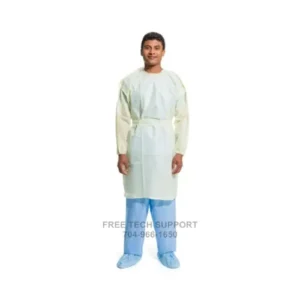
Halyard BASICS Tri-layer Isolation Gowns were painstakingly designed to meet the standards that have been set by AAMI (the Association for the Advancement of Medical Instrumentation) for advancing the safety and effectiveness of health technology. These gowns are AAMI Level 2 which is: Minimal to Low Fluid Barrier Protection – Used when there’s only a slight risk of fluid exposure, for minimally invasive surgical procedures such as lumps and bumps.
The secret lies in their use of SMS fabric (Spunbond-Meltblown-Spunbond), which is a multi-layer material that provides incredible fluid resistance, as well as superior breathability compared to any generic form of isolation gown. This means the wearer is protected from bodily fluids and other harmful substances while reducing discomfort associated with wearing gowns for long periods of time.
You can find more info on Halyard’s BASICS Isolation Gowns on our site here. →
Air Purification with OSO Pure
The battle against the pathogens doesn’t stop at the surfaces, they like to play dirty. And they’ll take the fight to the very air you breathe. So when it comes to combatting the bacteria in the air, you need the best in air purification. OSO Pure is a leading innovator in the various ways to purify the air in any scenario, whether it’s at work, home or even in your car. So let’s take a look at OSO Pure’s air purifiers.
Whether it’s indoors inside your workplace or practice, personal space or even your car… OSO Pure has a solution for every need. Their line of air purifiers can help take the fight against pathogens to the air; literally. Let’s take a look at what OSO Pure has to offer.
The ADP-70 for Your Rooms
For room service, we have the ADP-70 model from OSO Pure. That stands for Air Disinfecting Purifier-70.
The ADP 70 air disinfection utilizes a proven technology commonly used in hospital HVAC systems called Photocatalytic Oxidation ( PCO). These charged ions, referred to as Hydroxyl Radicals (HO), are powerful oxidizers that destroys particles as small as .001 microns. HEPA systems only filter particles down to .300 microns. The ADP 70 continuously emits HO for on contact removal of contaminants.
The ADP-70 is perfect for:
- Operatory areas
- Patient waiting or common areas
- Employee Break rooms
- Implant Processing
- Sterilization center
- Lab Processing
- Denture
- Waiting Rooms
- Any unconfined area where you want to control pathogens and odors.
You can find more info on OSO Pure ADP-70 on our site here. →
The OSO Pure ADP-V for Buildings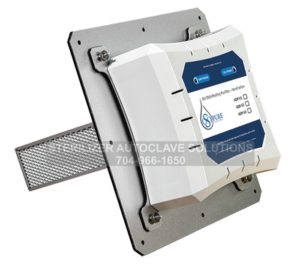
For your buildings, whether it be offices, medical practices, etc, we have the ADP-V line from OSO Pure. That stands for Air Disinfecting Purifier Ventilation.
The ADP-V Series air purifier installs in the practice’s HVAC system effectively oxidizing viruses, bacteria, mold, odors and VOC’s in the air and on surfaces. Unlike air filtration devices, the ADP emits powerful oxidizers that attack pathogens at the point of origin as opposed to waiting for them to be removed via filtration. Our process provides an extra layer of protection 24/7 to you, your staff and your patients.
Some of the ADP-V Series features are:
- Utilizes your existing system, purification is distributed evenly throughout the practice
- Reduces airborne and surface contaminants such as bacteria, viruses, VOCs, mold, and mildew
- Purifies the HVAC ducts and kills mold on the A-Coil and drip pan
- Eliminates odors at the source
- Ideal for most indoor spaces
- Safe for humans and pets
- LED function lights confirm continuous operation
- Low to no maintenance – replace cell every 2 years.
You can find more info on OSO Pure’s ADP-V purifier on our site here. →
The OSO Pure EVPP For Vehicles
When it comes to your vehicle’s air quality, OSO Pure even has you covered there. With their EVPP Mobile Disinfecting Purifier. That stands for Emergency Vehicle Personal Purifier
The EVPP is the perfect Air Purifier for emergency vehicles, your work vehicle, or desktop workspace. Utilizing PCO Technology along with Negative Ionization to purify air and surfaces, up to 99% of Bacteria, Viruses, Mold, Mildew, and other contaminants are rendered harmless. Odors like smoke are also eliminated, creating a cleaner safer work environment.
You can find more info on OSO Pure EVPP purifier on our site here. →
Final Thoughts
The medical world is full of invisible enemies—from persistent bacteria that are resistant to regular drugs, to ultra-fast spreading viruses, and sneaky fungi that only attack when someone is weak. It sounds intense, but the real secret to staying safe isn’t magic; it’s about having the right gear. Whether you use a dependable daily wipe like CaviWipes, a heavy-duty cleaner like PDI Super Sani-Cloth for extra dirty jobs, or the fast protective power of Optim 1 with its Accelerated Hydrogen Peroxide formula—knowing which one to grab is half the battle. When you understand the germs you’re fighting and you pick a wipe that’s strong enough to defeat the Norovirus and other tough bugs in seconds, you’re not just cleaning, you’re guaranteeing a safe space for everyone.
But that’s not all, you’ll need personal protection equipment too. No soldier goes into a battle without armor, and Halyard has you covered. Whether it’s nitrile gloves that can handle any situations like their lineup of standard to specialty gloves… Facial protection with Halyard’s Fluidshield N95 Respirator, and even a fluid barrier for the rest of your body with Halyard BASICS Tri-Layer Isolation gowns. And of course, you can’t forget to keep the air in your practice clean, with OSO Pure’s range of air purifiers that can even take it beyond the workplace.
So if you have any questions about infection prevention and infection control products like the ones we’ve mentioned here, give us a call at 704-966-1650, and we’ll help you find what you need.
As always if you have any questions about this process or anything else please feel free to contact us and take advantage of our “FREE TECH SUPPORT.”
We also offer FREE VIRTUAL TECH SUPPORT to “See and Talk” with a “Real Time Live Technician” for any problems you may be in need of help with.
You can also use our “FREE MAINTENANCE PROGRAM”. Take the guesswork and worrying about what unit is due for maintenance and which maintenance cycle it is time for. We will keep track of all your autoclaves and let you know when it’s time for anything.


